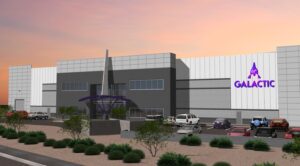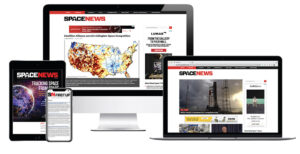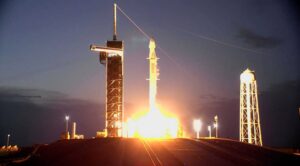Space rocket junk could have deadly consequences unless governments act
Friday, 15 July 2022 11:50 The re-entry of abandoned stages of rockets left in orbit from space launches have a six to 10 per cent chance of severely injuring or killing a human being in the next decade, according to a new UBC study.
Researchers say governments need to take collective action and mandate that rocket stages are guided safely back to Earth after their use, which could increase the cost of a launch, but
The re-entry of abandoned stages of rockets left in orbit from space launches have a six to 10 per cent chance of severely injuring or killing a human being in the next decade, according to a new UBC study.
Researchers say governments need to take collective action and mandate that rocket stages are guided safely back to Earth after their use, which could increase the cost of a launch, but Planet signs contract to provide German Federal Agencies with daily satellite imagery
Friday, 15 July 2022 11:50 Planet Labs has announced that its wholly owned subsidiary, Planet Labs Germany GmbH, has signed a new contract with the German Federal Agency for Cartography and Geodesy (BKG) to provide the agency with daily, high-resolution satellite data for crisis response, environmental and nature conservation, as well as forest and agricultural monitoring.
Access to Planet's satellite data will help
Planet Labs has announced that its wholly owned subsidiary, Planet Labs Germany GmbH, has signed a new contract with the German Federal Agency for Cartography and Geodesy (BKG) to provide the agency with daily, high-resolution satellite data for crisis response, environmental and nature conservation, as well as forest and agricultural monitoring.
Access to Planet's satellite data will help Ariane 6 central core transferred to mobile gantry
Friday, 15 July 2022 11:50 The Ariane 6 launch pad at Europe's Spaceport in French Guiana now hosts the first example of ESA's new heavy-lift rocket. This Ariane 6 combined tests model will be used to validate the entire launch system during its ground phase in readiness for the inaugural launch of Ariane 6.
The combined tests include filling tanks, and draining them in case of launch abort, count-down automated seq
The Ariane 6 launch pad at Europe's Spaceport in French Guiana now hosts the first example of ESA's new heavy-lift rocket. This Ariane 6 combined tests model will be used to validate the entire launch system during its ground phase in readiness for the inaugural launch of Ariane 6.
The combined tests include filling tanks, and draining them in case of launch abort, count-down automated seq Virgin Galactic selects Arizona for spaceplane manufacturing facility
Friday, 15 July 2022 10:34
Virgin Galactic announced July 14 plans to assemble a fleet of suborbital spaceplanes in a new factory in a suburb of Phoenix.
The post Virgin Galactic selects Arizona for spaceplane manufacturing facility appeared first on SpaceNews.
To search for alien life, astronomers will look for clues in the atmospheres of distant planets
Friday, 15 July 2022 09:32 The ingredients for life are spread throughout the universe. While Earth is the only known place in the universe with life, detecting life beyond Earth is a major goal of modern astronomy and planetary science.
We are two scientists who study exoplanets and astrobiology. Thanks in large part to next-generation telescopes like James Webb, researchers like us will soon be able to measure the
The ingredients for life are spread throughout the universe. While Earth is the only known place in the universe with life, detecting life beyond Earth is a major goal of modern astronomy and planetary science.
We are two scientists who study exoplanets and astrobiology. Thanks in large part to next-generation telescopes like James Webb, researchers like us will soon be able to measure the Webb Images of Jupiter and More Now Available In Commissioning Data
Friday, 15 July 2022 09:32 On the heels of Tuesday's release of the first images from NASA's James Webb Space Telescope, data from the telescope's commissioning period is now being released on the Space Telescope Science Institute's Mikulski Archive for Space Telescopes. The data includes images of Jupiter and images and spectra of several asteroids, captured to test the telescope's instruments before science operations o
On the heels of Tuesday's release of the first images from NASA's James Webb Space Telescope, data from the telescope's commissioning period is now being released on the Space Telescope Science Institute's Mikulski Archive for Space Telescopes. The data includes images of Jupiter and images and spectra of several asteroids, captured to test the telescope's instruments before science operations o Ukrainian Space Startups
Friday, 15 July 2022 09:32 In 2016 and 2018, I was invited to Ukraine. I gave speeches about the Space Revolution at the Kyiv Polytechnic Institute, in Dnipro and other venues, and met with the Mayors, leaders of the Rada, the Ukrainian cosmonaut corps, and other space leaders, as well as several groups of their rising tech community.
The folks I met there, just a couple of years after what they refer to as the "Mai
In 2016 and 2018, I was invited to Ukraine. I gave speeches about the Space Revolution at the Kyiv Polytechnic Institute, in Dnipro and other venues, and met with the Mayors, leaders of the Rada, the Ukrainian cosmonaut corps, and other space leaders, as well as several groups of their rising tech community.
The folks I met there, just a couple of years after what they refer to as the "Mai Swarm dodges collision during climb to escape Sun's wrath
Friday, 15 July 2022 09:32 The pressure is on at ESA's mission control. An ESA satellite dodges out of the way of a mystery piece of space junk spotted just hours before a potential collision.
Now a crucial step in the spacecraft's ongoing journey to safer skies has to be quickly rescheduled, as violent solar activity related to the ramping up of the solar cycle warps Earth's atmosphere and threatens to drag it down
The pressure is on at ESA's mission control. An ESA satellite dodges out of the way of a mystery piece of space junk spotted just hours before a potential collision.
Now a crucial step in the spacecraft's ongoing journey to safer skies has to be quickly rescheduled, as violent solar activity related to the ramping up of the solar cycle warps Earth's atmosphere and threatens to drag it down NASA, SpaceX launch climate science research to ISS
Friday, 15 July 2022 09:32 A SpaceX Dragon resupply spacecraft carrying more than 5,800 pounds of science experiments, crew supplies, and other cargo is on its way to the International Space Station after launching at 8:44 p.m. EDT Thursday from NASA's Kennedy Space Center in Florida.
The spacecraft launched on a Falcon 9 rocket from Launch Pad 39A at Kennedy for the company's 25th commercial resupply services missi
A SpaceX Dragon resupply spacecraft carrying more than 5,800 pounds of science experiments, crew supplies, and other cargo is on its way to the International Space Station after launching at 8:44 p.m. EDT Thursday from NASA's Kennedy Space Center in Florida.
The spacecraft launched on a Falcon 9 rocket from Launch Pad 39A at Kennedy for the company's 25th commercial resupply services missi Rocket Lab's MAX Flight Software surpasses 50th mission milestone
Friday, 15 July 2022 09:32 Rocket Lab USA, Inc. (Nasdaq: RKLB) has achieved a major milestone in Q2 with its MAX Flight Software now operating on 53 spacecraft, for a cumulative 161 years in space.
Developed by Colorado-based Advanced Solutions Inc (ASI), which was acquired by Rocket Lab in October 2021, the off-the-shelf spacecraft flight software, MAX, supports a wide range of missions and all spacecraft subsystem
Rocket Lab USA, Inc. (Nasdaq: RKLB) has achieved a major milestone in Q2 with its MAX Flight Software now operating on 53 spacecraft, for a cumulative 161 years in space.
Developed by Colorado-based Advanced Solutions Inc (ASI), which was acquired by Rocket Lab in October 2021, the off-the-shelf spacecraft flight software, MAX, supports a wide range of missions and all spacecraft subsystem NASA's New Mineral Dust Detector Readies for Launch
Friday, 15 July 2022 09:32 Each year, strong winds carry more than a billion metric tons - or the weight of 10,000 aircraft carriers - of mineral dust from Earth's deserts and other dry regions through the atmosphere. While scientists know that the dust affects the environment and climate, they don't have enough data to determine, in detail, what those effects are or may be in the future - at least not yet.
Set to l
Each year, strong winds carry more than a billion metric tons - or the weight of 10,000 aircraft carriers - of mineral dust from Earth's deserts and other dry regions through the atmosphere. While scientists know that the dust affects the environment and climate, they don't have enough data to determine, in detail, what those effects are or may be in the future - at least not yet.
Set to l BlackSky Wins $4.4 Million IARPA Contract to Provide Advanced Artificial Intelligence for Space-Based Dynamic Monitoring
Friday, 15 July 2022 09:32 "As part of our work, BlackSky created a high-performance MLOps (machine learning operations) framework that was ultimately selected to perform as the core infrastructure to the entire SMART program," said Patrick O'Neil, BlackSky chief innovation officer.
"The MLOps framework will extend BlackSky's Spectra AI tasking and analytics capabilities and accelerate the development of SMART tec
"As part of our work, BlackSky created a high-performance MLOps (machine learning operations) framework that was ultimately selected to perform as the core infrastructure to the entire SMART program," said Patrick O'Neil, BlackSky chief innovation officer.
"The MLOps framework will extend BlackSky's Spectra AI tasking and analytics capabilities and accelerate the development of SMART tec
We want to hear from you
Friday, 15 July 2022 08:19
SpaceNews is conducting a reader survey to learn more about our audience and your expectations.
The post We want to hear from you appeared first on SpaceNews.
SpaceX launches cargo Dragon mission to ISS
Friday, 15 July 2022 01:26
A SpaceX cargo Dragon spacecraft is on its way to the International Space Station after a July 14 launch delayed more than a month by a hydrazine leak on the spacecraft.
House of Representatives passes 2023 defense authorization bill
Thursday, 14 July 2022 23:13
The House on July 14 passed the 2023 National Defense Authorization Act by a vote of 329-101.
The post House of Representatives passes 2023 defense authorization bill appeared first on SpaceNews.

